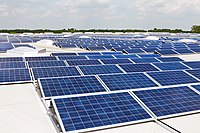
Photo from wikipedia
Abstract In Turkey, Southeastern Anatolia region is the highest in terms of solar radiation level. However, the provinces in the region are subject to Particulate Matter (PM) coming from the… Click to show full abstract
Abstract In Turkey, Southeastern Anatolia region is the highest in terms of solar radiation level. However, the provinces in the region are subject to Particulate Matter (PM) coming from the Sahara desert, the Syrian Desert and the Arabian Desert by atmospheric transport. The daily limit of PM10 and PM2.5 set by WHO for health is often exceeded in Sanliurfa. PM10 and PM2.5 pollutants also accumulate on the Photovoltaic (PV) panels and cause loss of PV panel performance. In this study, the effects of atmospheric dust deposition on the performance of PV panel was determined for both monocrystalline and polycrystalline technologies under Sanliurfa atmospheric conditions. Two panels with the same characteristics were used for each PV panel group from 2 different PV technologies. One of the panels in the group was cleaned by washing with distilled water every Monday while the other was not cleaned. Thus, the effect of the dust accumulation on the PV panel was determined by comparison to the cleaned PV panel. PV panel power is measured with I–V meter. Panel surface temperature, solar radiation and other meteorological parameters are measured simultaneously. The measurements were done every Monday, Wednesday and Friday at 12:00 am from May 1 to December 31, 2019. It is observed that the dust accumulation reduces the PV power output up to 8% depending on the amount of radiation. During the summer months, the power loss on the average is 4.33% for monocrystalline and 4.57% for polycrystalline. In the autumn months, it is less than 1.77%.
Journal Title: Atmospheric Pollution Research
Year Published: 2020
Link to full text (if available)
Share on Social Media: Sign Up to like & get
recommendations!